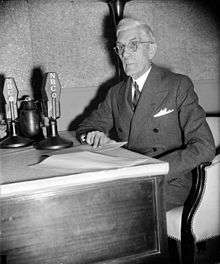Francis Townsend

Francis Everett Townsend (/ˈtaʊnzənd/; January 13, 1867 – September 1, 1960) was an American physician who was best known for his revolving old-age pension proposal during the Great Depression. Known as the "Townsend Plan", this proposal influenced the establishment of the Roosevelt administration's Social Security system. He was born just outside Fairbury, Illinois, where he is memorialized by a post office named in his honor.
Biography
Francis Everett Townsend was born the second of six children on January 13, 1867 in Fairbury, Illinois.[1] After Townsend contracted swamp malaria as an infant, the Townsend family moved to Nebraska where Townsend had two years of high school education.[1] In 1898, Townsend borrowed $1,000 from his father and moved to Southern California to develop a hay farming business.[1] The business was not successful and Townsend enrolled in Omaha Medical College when he was 31.[1] After graduating, Townsend worked in the medical field in Belle Fourche, South Dakota and met a nurse and his future wife, Wilhelmina "Minnie" Bogue.[1] At age 50, Townsend enlisted as a doctor in the army one year before the end of World War I.[1]
After the war ended in 1918, Townsend moved to Long Beach, California to run a dry ice factory.[1] After that business quickly failed, Townsend worked for real estate agent Robert Earl Clements in Midway City, California.[1] Clements later masterminded the Townsend Plan.[1] In 1930, at the start of the Great Depression, Townsend became a Long Beach city public health officer at age 63, but lost his job three years later.[1]
The Townsend Plan
The Townsend Plan proposed that every person over 60 be paid $200 per month. The Old-Age Revolving Pension fund was to be supported by a 2% national sales tax.[2]
There were three requirements for beneficiaries under the Plan:
- they had to be retired;
- they had to be "free from habitual criminality;"
- they had to spend the money within 30 days (to stimulate the economy.)[2]
Promoting the plan

In September 1933, Townsend wrote a letter to the editor of the local newspaper (the Long Beach Press-Telegram)[3] and launched his career as an old-age activist.[1] Townsend and Earl Clements then employed the techniques of real estate salesmanship to gain support for the Townsend Plan. Soon there were organizers in almost every state seeking to create Townsend Plan programs.
Notes
- 1 2 3 4 5 6 7 8 9 10 11 Amenta, Edwin (2006). When Movements Matter: The Townsend Plan and the Rise of Social Security. Princeton University Press. pp. 36–38. ISBN 0691124736. Retrieved May 26, 2012.
- 1 2 Larry Dewitt (December 2001). "Research Note #17: The Townsend Plan's Pension Scheme". Research Notes & Special Studies by the Historian's Office, Social Security Administration. Retrieved October 26, 2014.
- ↑ David Dayen (October 29, 2013). "How a Frustrated Blogger Made Expanding Social Security a Respectable Idea". Pacific Standard. Retrieved January 13, 2014.
External links
- US Social Security Administration, "The Townsend Plan Movement," Social Security History.
 Media related to Francis Townsend at Wikimedia Commons
Media related to Francis Townsend at Wikimedia Commons